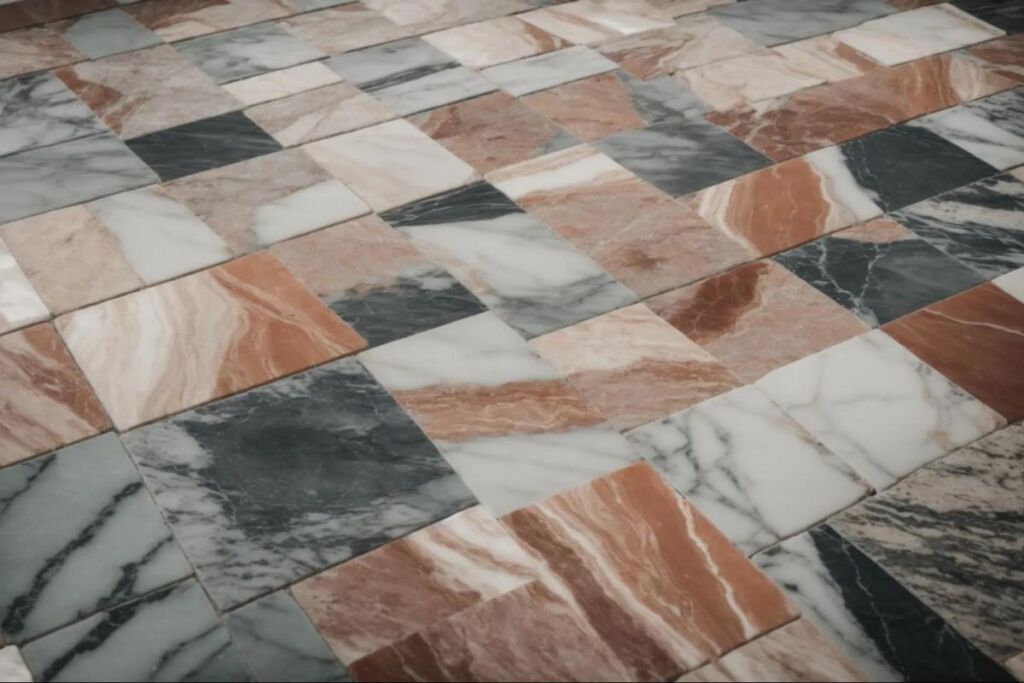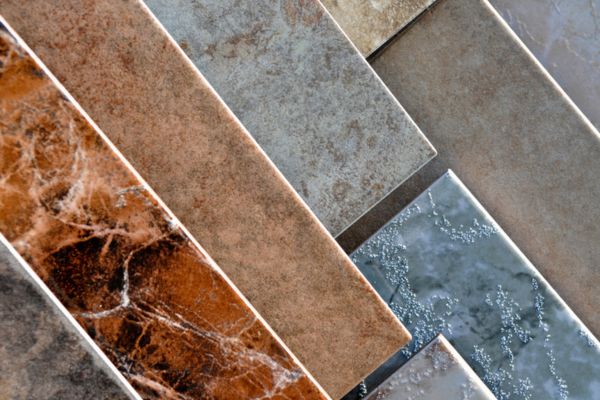
There’s a certain timeless elegance that marble flooring brings to any space. The smooth, luxurious surface, the intricate patterns, and the natural variations in color—all contribute to an atmosphere of sophistication and refinement.
Choosing the right type of marble for a space is important for its aesthetic appeal, durability, and functionality. It should harmonize with the overall design, withstand wear and tear, and fit the budget. Factors like maintenance, environmental impact, and long-term real estate value also play crucial roles in decision-making.
In this comprehensive guide, we’ll discuss everything about marble flooring. We will explore the various marble flooring types available and provide insights to help you make the best choice for your home or project.
Types of Marble Flooring
Marble flooring comes in a variety of types, each with its own distinct characteristics and aesthetic appeal. Here are some of the types you might want to know:
Carrara
Carrara marble is a type of white or blue-gray marble popular for use in sculpture and building decor. It has been quarried since Roman times in the mountains just outside the city of Carrara in Italy and was called “Luna marble” by the Romans.
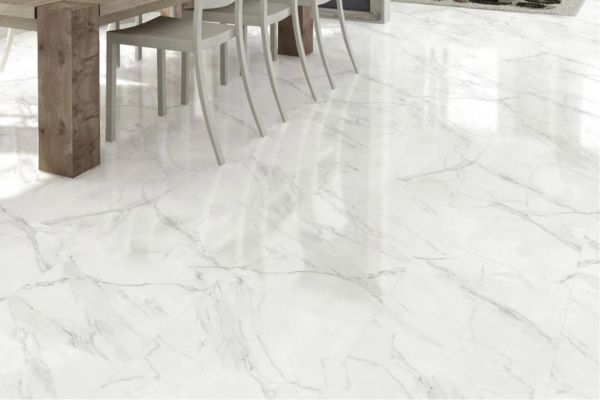
Pros:
- Classic: Carrara marble offers a timeless and elegant look with its white or blue-gray hues. It complements many design styles and adds a touch of luxury to any space.
- Heat Resistant: Unlike some other countertop materials, Carrara marble can tolerate hot pots and pans without burning.
- Relatively Affordable (for marble): While still on the expensive side, Carrara marble is generally more affordable compared to other marble varieties.
Cons:
- Porous and Stains Easily: Carrara marble absorbs liquids readily. This can lead to staining from acidic liquids like wine, coffee, or citrus juice.
- Scratches and Etches: Carrara marble is a soft stone and can scratch or etch more easily than harder countertop materials. Etching is a dulling of the surface where the polish is worn away.
- Requires Regular Maintenance: To maintain its beauty and prevent staining, Carrara marble requires regular sealing and cleaning with special products.
Ideal Applications
Carrara marble shines (literally!) in certain applications due to its strengths and aesthetics. It is mostly used for interior design elements (countertops, backsplashes, etc.), sculptural works, and low-traffic areas.
Calacatta Marble
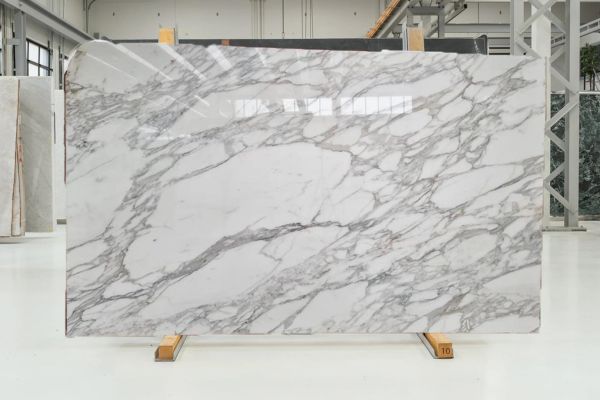
Calacatta marble is a type of high-end marble prized for its beauty and rarity and is known for its dramatic veining. The background is a clean, bright white, and the veins are bold and thick, often with streaks of gray, beige, gold, or even rusty orange.
Pros:
- Stunning Aesthetics: Undeniably beautiful, the bold veining and clean white background create a dramatic, luxurious look.
- Heat Resistant: Marble naturally stays cool, making it a good choice for countertops, especially for baking or working with chocolate.
- Potential Investment: Some experts believe Calacatta marble can increase your home’s resale value due to its rarity and high-end status.
- Unique Every Time: Since it’s a natural stone, each slab of Calacatta marble has one-of-a-kind patterns, ensuring a truly unique design element.
Cons:
- High Maintenance: Calacatta marble is porous and susceptible to staining from acidic liquids like wine, vinegar, or citrus juice. It requires regular sealing and careful cleaning.
- Prone to Etching: Acidic liquids can etch the marble’s surface, leaving dull spots.
- Costly: Due to its rarity, Calacatta marble comes with a hefty price tag compared to other countertop materials.
- Limited Availability: Finding Calacatta marble can be challenging depending on your location.
- Bold Veining: The dramatic veining might not be for everyone. Some people prefer a more subtle look.
Ideal Applications
Calacatta marble is best suited for areas with low traffic and wear and tear where its beauty can be truly appreciated. It’s recommended for low-use bathroom countertops, shower walls, flooring, and accent walls. Remember, Calacatta marble requires a certain level of care and comes at a premium price. Weigh the pros and cons carefully to determine if it fits your lifestyle and budget.
Statuario Marble
Statuario marble is from the mountains of Carrara, Italy, and is known for its striking white background with dramatic veins of grey and sometimes gold. Statuario marble slab was a favorite of sculptors, including Michelangelo, and its name reflects this history – “statuario” means “of statues” in Italian.
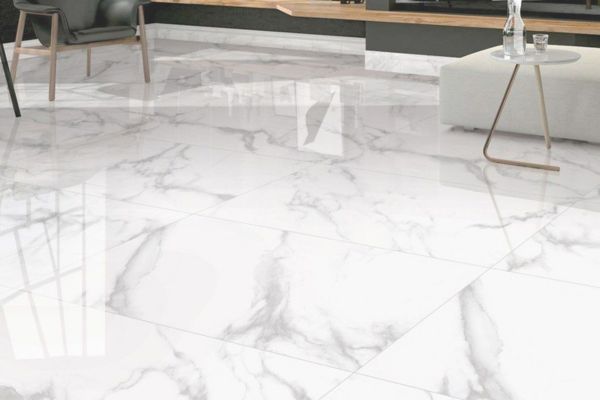
Pros:
- Durability: Statuario marble, particularly when polished, is surprisingly durable and can withstand wear and tear in high-traffic areas.
- Heat Resistance: It’s naturally heat resistant, making it suitable for kitchens (with proper care).
- Investment Value: Due to its rarity and looks, Statuario marble can add value to your real estate.
Cons:
- Porous: Statuario marble can easily stain if you spill acidic liquids like wine or vinegar. It requires regular sealing to maintain its beauty.
- Scratch-prone: The surface can scratch if you use harsh cleaners or abrasive materials.
- High Maintenance: Regular cleaning, sealing, and stain removal are necessary to keep it looking its best.
- Slippery: The polished surface can be slippery when wet.
Ideal Applications
Statuario marble is best suited for areas where its beauty can be appreciated and where maintenance isn’t a major concern. Most of the time, this type of marble is applied to low-traffic areas, furniture elements, wall tiles, countertops, and flooring.
Crema Marfil Marble
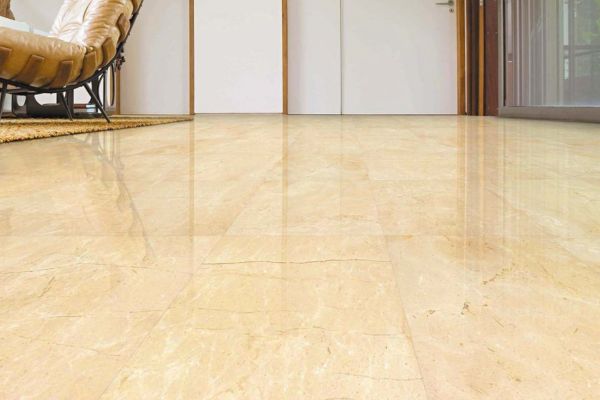
Crema Marfil Marble is a beautiful beige marble quarried in Spain. It’s a popular choice due to its elegant appearance and durability. Crema Marfil has a soft, creamy background with veins of color that can range from yellow to gold to brown. The veining can be subtle or dramatic, depending on the specific piece of marble.
Pros:
- Durable (for certain applications): When used indoors with proper care, Crema Marfil can last a long time.
- Versatile: It comes in various finishes (polished or honed) and can be used for countertops, flooring, wall cladding, and other features.
- Price Range: Depending on the grade and veining, Crema Marfil can be found at different price points, making it potentially more accessible than other high-end stones.
Cons:
- Susceptible to Staining: As a natural stone, Crema Marfil is porous and prone to staining from acidic liquids like wine, vinegar, or citrus. Regular sealing is crucial.
- Scratches and Etching: It’s a soft stone compared to granite and can scratch or etch more easily.
- High Maintenance: Regular cleaning, sealing, and avoiding harsh chemicals are necessary to maintain its beauty.
- Limited Outdoor Use: Not ideal for exterior applications due to potential staining and weather damage.
Ideal Applications
Crema Marfil is best suited for areas with low traffic and minimal exposure to acidic liquids or stains. Its elegant look can easily complement low-use bathrooms, light-traffic flooring, and interior wall cladding. If you prioritize durability and low maintenance, other stones like granite or quartz might be better choices for countertops or high-traffic areas. But if you love the luxurious aesthetic and are willing to invest in proper care, Crema Marfil can be a stunning addition to your home.
You might like: What Are the Best Types of Wood for Families
Emperador Marble
Emperador marble is a beautiful natural stone prized for its warm, rich brown color and intricate veining patterns. It’s a popular choice in various architectural and design applications due to its distinctive color. There are two types of Emperador marbles: dark and light.
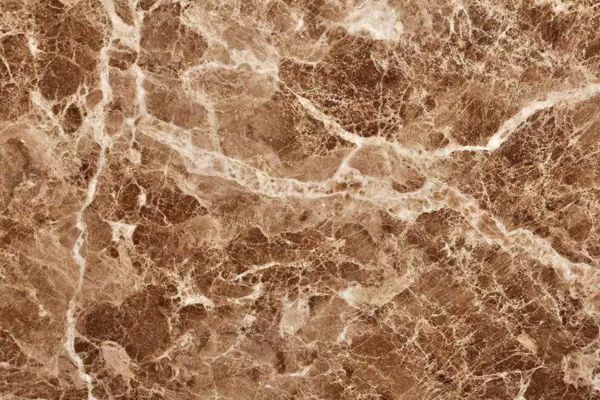
Pros:
- Beautiful and Luxurious: Emperador marble’s warm brown tones and veining patterns create a high-end look that can elevate any space.
- Durable: It’s a natural stone known for its resilience and can withstand wear and tear for many years with proper care.
- Versatile: Available in various finishes, it can be used for countertops, flooring, wall cladding, and more. The neutral brown tones also complement a variety of design styles.
- Easy Maintenance: Regular cleaning with a mild detergent and resealing periodically keeps it looking its best.
Cons:
- Porous: Susceptible to staining if not sealed properly. Acidic liquids like vinegar or citrus juices can etch the surface.
- High Maintenance: Requires regular sealing, which can be a hassle for some homeowners.
- Susceptible to Scratches: While durable, it can scratch if exposed to sharp objects or abrasive cleaners.
- Costly: Natural stone like Emperador marble is a premium material and comes with a higher price tag compared to other countertop options.
Ideal Applications
Emperador marble is perfect for creating a high-end and luxurious feel in various areas of your home, given proper maintenance is followed. It is ideal to apply Emperador marble in kitchen countertops, accent walls, shower surrounds, fireplace surrounds, and bathroom vanities.
Factors to Consider When Choosing Marble Flooring
Marble flooring adds a touch of luxury and sophistication to any space. However, choosing the right marble requires careful consideration of several factors:
Durability
Marble’s durability makes it an excellent long-term investment for your home or business. However, since marble is a natural stone, its durability can vary depending on factors like its density and porosity.
Choose marble with a higher density and lower porosity. These types of marble are less prone to staining and scratching, ensuring your flooring maintains its beauty for years to come.
Maintenance Requirements
Marble is prone to etching from acidic substances like lemon juice or vinegar, so it’s important to clean up spills promptly and avoid using harsh cleaning products.
Regular sealing is also necessary to protect the marble from staining and moisture damage. Depending on the type of marble and its usage, sealing may need to be done annually or more frequently in high-traffic areas.
Color and Veining Patterns
Always consider the overall aesthetic you want to achieve and how the color and veining will complement your space.
Lighter marble colors like white or beige can brighten up a room and create a sense of spaciousness, while darker colors like black or grey add a touch of elegance and drama. Veining patterns range from subtle and delicate to bold and dramatic, so choose one that enhances the style of your space.
Budget Considerations
Marble flooring comes in a wide range of price points, depending on factors such as rarity, quality, and origin.
Carrara marble, for example, is more affordable and readily available, making it a popular choice for many homeowners. On the other hand, rare and exotic marble varieties can be much more expensive, but some homeowners feel the investment is worth the return.
Installation and Maintenance Tips
Installing and maintaining marble flooring requires careful attention to detail to ensure its longevity and beauty. Here are some tips to help you through the process:
Proper Installation Techniques
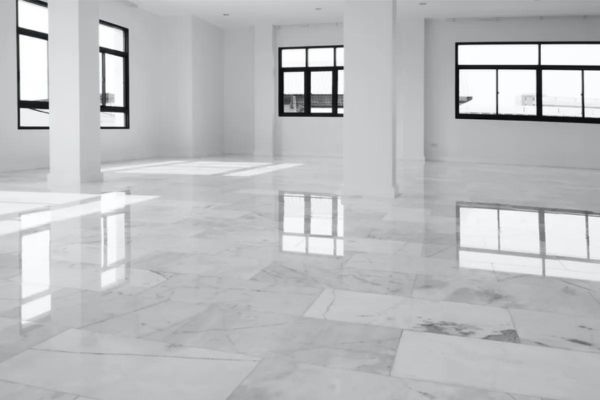
Ensure that the subfloor is clean, level, and dry before laying the marble tiles. Use a high-quality thin-set mortar and follow the manufacturer’s instructions for mixing and application.
When laying the tiles, maintain consistent spacing between them for a uniform look. Use plastic tile spacers to achieve the desired spacing and check with a level to ensure the tiles are even.
After laying the tiles, allow the mortar to cure completely before grouting. Once the grout is applied and dried, seal the marble to protect it from moisture and stains.
Related Post: 5 Tips to Help You Hire a Good Flooring Contractor
Regular Maintenance Routines
Regular maintenance is crucial for preserving the beauty of your marble flooring. Sweep or vacuum the floor regularly to remove dirt and debris that can scratch the surface. Avoid using abrasive cleaning tools like stiff brushes or scouring pads, as these can damage the marble.
For deeper cleaning, mop the floor with a neutral pH cleaner and warm water. Avoid using acidic or abrasive cleaners, as these can etch the marble and dull its appearance.
Cleaning and Sealing Recommendations
To clean the marble, use a soft cloth or sponge dampened with a mild detergent solution. Avoid using vinegar or other acidic cleaners, as these can damage the marble.
After cleaning, seal the marble to protect your floor from stains and moisture. Choose a high-quality marble sealer and follow the manufacturer’s instructions for application. Generally, the sealer should be applied using a clean cloth or brush, allowed to penetrate the marble, and then wiped of any excess.
Regularly check the condition of the sealer and reapply it as needed. To test if the sealer is still effective, sprinkle a few drops of water on the marble. If the water beads up, the sealer is still working. If it soaks into the marble, it’s time to reseal.
Conclusion
Marble flooring offers an unmatched combination of beauty, durability, and timeless elegance. From the classic allure of Carrara to the luxurious opulence of Calacatta, each type of marble brings its unique charm to any space.
Whether you’re drawn to the soft, subtle veining of Carrara, the bold, dramatic patterns of Emperador, or something in between, there’s a marble flooring option that will suit your style and needs. With proper care and maintenance, your marble flooring will maintain its polish for years to come.
If you need help in choosing a marble type for your home or office, call a reputable marble flooring contractor like Murfreesboro Flooring to help you install marble flooring. You’ll be glad you did.

